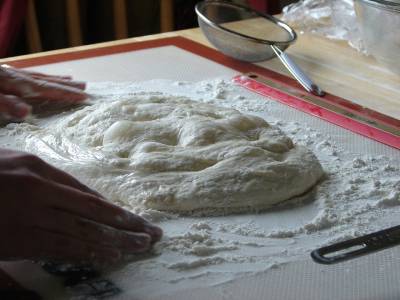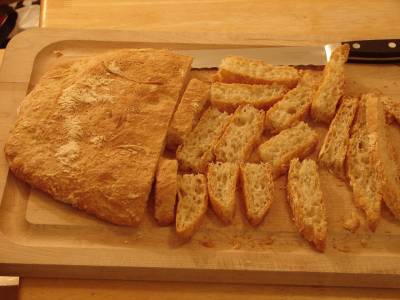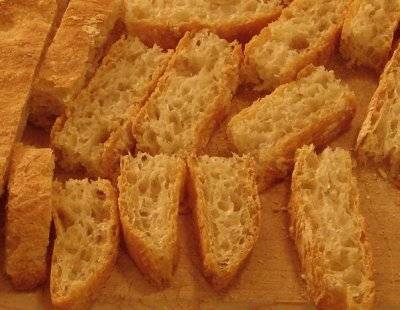Ciabatta is a classic artisan Italian bread with a golden crusty outside and a very light, airy inside. The best ciabattas have large wholes distributed evenly throughout the loaf, while the crust is firm and slightly “wrinkly” on top. This recipe, being an adaptation from Rose Levy Beranbaum’s Ciabatta, accomplishes all those things. It produces the kind of bread that you dream of when you first lay your eyes on bread making – a real artisan bread with good flavor, but even more importantly, wonderful texture.
While the time schedule is similar to those of other artisan breads – you make a biga that most conveniently rests in the fridge over night, it is isn’t a terribly busy schedule. Once the biga is done, all you need is slightly over three hours back and forth. Ciabattas are made with doughs with exceptionally high water content, and that makes it almost impossible to knead by hand. Therefore, you’re better off utilizing a mixer.
It is a lot of fun working with this dough. The very wet dough is so smooth to the touch and really interesting to shape. You have to be careful not push out too much air, however it is a slight challenge, because the dough is so malleable and almost slippery. When making this bread, you certainly want some steam in order to produce a nice crust, so prepare the cast-iron pan and have ice ready on hand. 1 bread
Dough Starter (Biga)
½ cup plus ½ tablespoon all-purpose flour
1/16 teaspoon instant yeast
¼ cup water, room temperature
Dough
Scant 1 cup all-purpose flour
¼ teaspoon instant yeast
½ teaspoon salt
½ cup water
Dough Starter (Biga)
Method:
1. Make the biga by mixing together all purpose flour, yeast and water in a small bowl. Stir with a wooden spoon for about 3 minutes until it is very smooth. Cover with oiled plastic wrap and let sit in room temperature for about 6 hours until it has doubled and is filled with bubbles. Now you can either use it right away, or refrigerate it up to 3 days. refrigerate it up to 3 days.
2. Make the dough by whisking together the flour and the yeast. Mix in the salt, then add the water and the biga. Using a mixer, mix on low speed with the paddle attachment for a few seconds until the floured is moistened. Raise the speed to medium-high and beat for 3 minutes, then lower the speed to medium and continue to beat for another 2 minutes.
3. Scrape the dough into an oiled 1 quart bowl, cover with oiled plastic wrap and let rise until tripled, 1 ¼ hour to 2 hours, ideally in 75 – 80 degrees. (If your kitchen is colder than that, you can put your oven on warm for a minute, then shut it off and leave the dough inside the oven for the rising period).
4. Scrape the dough out on a generously flour-sifted counter, the dough will be quite wet. Sift more flour on top of the dough. Trying to maintain as much air as possible inside the dough, gently push the sides of the dough together in order to produce a wrinkled pattern on the bottom of the dough which will later become the top. Make large dimples in the dough, using your finger tips, about one inch apart, then push the sides together again. Now, carefully lift the dough up and invert it onto a lined baking sheet. This can be rather tricky, since the dough is so loose and you don’t want to flatten it too much. If you have two people on hand, it makes it easier since you both can lift it with large pancake flippers from both sides and gently tip it over to the baking sheet. Again, push the sides together and shape it to 4 ½ inches wide, sift more flour on top and cover with oiled plastic wrap. Allow to rise about 1 ½ to 2 hours. the dough, using your finger tips, about one inch apart, then push the sides together again. Now, carefully lift the dough up and invert it onto a lined baking sheet. This can be rather tricky, since the dough is so loose and you don’t want to flatten it too much. If you have two people on hand, it makes it easier since you both can lift it with large pancake flippers from both sides and gently tip it over to the baking sheet. Again, push the sides together and shape it to 4 ½ inches wide, sift more flour on top and cover with oiled plastic wrap. Allow to rise about 1 ½ to 2 hours.
5. Preheat the oven to 475 degrees (it is recommended that you pre-heat the oven an hour before baking). On the lowest shelf in the oven, place a cast-iron pan or a sheet pan. Above, place a baking stone or a sheet pan.
6. Gently set the bread on the hot stone. Toss ½ cup of ice cubes into the pan beneath and shut the door immediately. Bake for 5 minutes, then lower the temperature to 450 degrees and continue to bake for about 20 minutes or until the bread is golden brown and an instant read thermometer in the center reads 214 degrees. Turn the bread around halfway through baking. Once the bread is done, turn off the oven, leave the door slightly ajar and allow the bread to cool slightly in the oven for 5 minutes. This process helps to develop a nice crust. ajar and allow the bread to cool slightly in the oven for 5 minutes. This process helps to develop a nice crust.
Remove it from the oven and set it on a wire rack and let cool completely.
|

